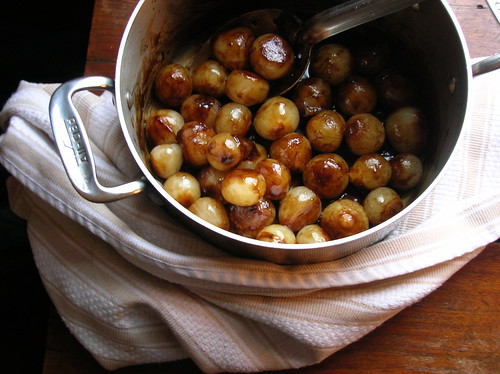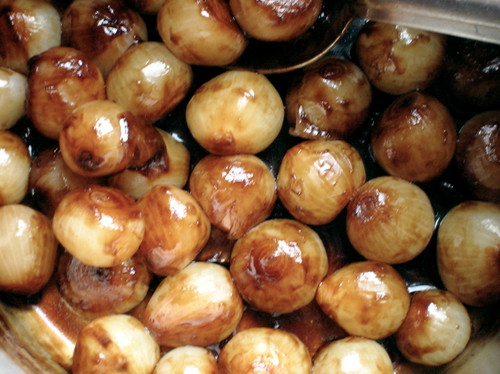 Tamarind is a sweet-tart fruit that comes from the pods of tamarind trees. Though native to Africa, tamarind is used in Middle Eastern cuisine, most commonly in the form of a tamarind drink. Aleppo, in northern Syria, is famous for its highly developped cuisine which is quite distinct from other parts of the region. The Arab name for Aleppo is Halab, derived from the word for milk (haleeb) on account of its excellent dairy products, it seems Aleppo has always been associated with great food. There are several key ingredients that are hallmarks of Aleppian cuisine: smoky-hot spices in the form of Aleppo pepper, plenty of red peppers, tart tangy pomegranate molasses, and the use of tamarind concentrate. These aspects of Aleppian cuisine developped as a result of many factors: Aleppo was a major city on ancient trade routes like the Silk Road, also the presence of Armenian immigrants, nearby Kurds and a strong Jewish community (though no longer extent) have all contributed to a unique repertoire of dishes.
Tamarind is a sweet-tart fruit that comes from the pods of tamarind trees. Though native to Africa, tamarind is used in Middle Eastern cuisine, most commonly in the form of a tamarind drink. Aleppo, in northern Syria, is famous for its highly developped cuisine which is quite distinct from other parts of the region. The Arab name for Aleppo is Halab, derived from the word for milk (haleeb) on account of its excellent dairy products, it seems Aleppo has always been associated with great food. There are several key ingredients that are hallmarks of Aleppian cuisine: smoky-hot spices in the form of Aleppo pepper, plenty of red peppers, tart tangy pomegranate molasses, and the use of tamarind concentrate. These aspects of Aleppian cuisine developped as a result of many factors: Aleppo was a major city on ancient trade routes like the Silk Road, also the presence of Armenian immigrants, nearby Kurds and a strong Jewish community (though no longer extent) have all contributed to a unique repertoire of dishes. 
Tamarind came to the Middle East by way of India, where it is popular, hence its name in Arabic tamr hindi, or Indian date. In Aleppo, the tamarind concentrate made by extracting the thick viscuous syrup from the fruit’s pulp is known as ou. Ou is an important ingredient in everything from soup broths to tomato sauces to bulgur salads. In a uniquely Aleppian dish called mehshi basal, onions are formed into rolls stuffed with a meat mixture, and then simmered in a tamarind sauce. A simpler version involves small baby onions simmered in that sweet-sour sauce.
I prefer this second (albeit less traditional) version, not only because it’s easier, but mainly because I love pearl onions. We always have little baby onions at the holidays, and the poor person who volunteers to help me in the kitchen usually gets stuck with the task of peeling them (and I wonder why they stop asking?). These tamarind glazed onions are quite similar to the popular Italian cippoline in agrodolce but I like the way the sauce is even thicker and tangier than those made with balsamic vinegar. The recipe’s provenance may be far away, but spearing them with a fork as they slippery-slither across the plate, crashing into the potatoes, the onion layers bursting from inside each other, and finally using the last bit of sauce to coat your entree, it tastes like the holidays to me.

Tamarind-Glazed Pearl Onions
Tamarind concentrate is available at Whole Foods and international markets, it keeps well and has many uses so it's a great addition to your pantry. This Syrian version of sweet-and-sour onions has a great thick and tangy sauce.
2 pounds white pearl onions (about 30)
3 tablespoons extra-virgin olive oil
3 tablespoons tamarind concentrate
1 tablespoon lemon juice
3-4 tablespoons sugar, to taste
pinch of salt
1. Heat a large pot of water to boiling. Trim off the base and tips of the onions. Submerge the onions in the water and let boil 7 minutes. Drain the onions into a colander and rinse with cold water. Slip the peels off the onions.
2. Heat the olive oil in a saucepan. Add the peeled onions and saute over medium heat for 5 minutes, until just browned. Add the tamarind, lemon, sugar and salt and cook until the mixture caramelizes and turns sticky, 3-5 more minutes. Taste for seasoning. Serve at room temperature.
P.S. If you don't have tamarind concentrate on hand, the recipe works perfectly well using balsamic vinegar instead.
____________________________________






10 comments:
Wow, Mercedes, these look delicious! I had no idea Tamarind was used in Middle Eastern cuisine. I've had it a lot in Thai and Mexican food, so it's a big surprise that it's native to Africa. Being vegetarian I won't have any roast beast of any kind on my plate, but I'm sure they would be fabulous with mashed potatoes or roasted squash. Yum! Thanks so much for submitting it to Tastespotting, so I could be reminded of your inspiring recipes.
This looks great.
I love tamarind and using it often in my Thai cooking, but now I can expand my horizons!
I have also discovered tamarind margaritas! Tamarind concentrate works perfect in place of sweet and sour mix in drinks :-)
I love the flavor of tamarind...I love pearl onions...This looks perfect!
I usually don't like onions but this dish looks FANTASTIC! I love the tamarind flavors and you make those pearl onions look beautiful.
Kifik! I am normally grossed out by the texture of pearl onions, but this recipe makes me want to give them another try!
Thanks for writing, and its great to see other arabic food bloggers!
Salaam,
Kate
Wow, this recipe looks delicious! I'm always looking for new ways to use the giant jar of Tamarind concentrate in my pantry, which, admittedly, often pines away for want of a recipe... Thank you for giving me a new dish to try!
That brings memories!!! my father was from Aleppo, and ou was part of my childhood - any idea where I can find this treasure?
Bri- I had no idea tamarind was part of Mexican cuisine, but now that you say it, I remember the Mexican tamarind sodas and candies and it makes total sense. Thanks for that reminder!
DP- it seems like so many cultures (except American !!) use tamarind, the margaritas are a great idea!
Meeso- sounds like this recipe's right up your alley!
Hillary- is it possible to cook and not like onions??!! Anyway, I hope you give this a try and maybe change your mind, onions can have lots of sweet and complex flavors.
Wild Thyme- oh no, I love the pearl onions, but I bet you could make this with other onions (cippoline or sliced larger onions) if you prefer. Salameh!
Astra- I know exactly what you mean, my jar of tamarind has been languishing for quite a while, but once I started cooking Aleppian cuisine it's been in high rotation, and now I can think of a zillion uses for it. Luckily it keeps well though.
Nava- in my experience ou is pretty much just like tamarind concentrate, which you can buy in many groceries. I usually use Tamicon brand, which you can get at most international groceries or Whole Foods. If you have access to fresh tamarind you can also make your own ou, let me know and I'd be happy to send you a recipe.
I saw a recipe for ou in the book "Aromas of Aleppo" (great book, by the way), but alas, no access to fresh tamarind...
Thank you so much for the Tamicon tip!!!
Hi Mercedes!
I´m soooo glad I foound your chat! I´m trying to make my first batch of ou as we speak! I have my mother-in-law´s recipe which is never totally trustable, and I have the "Aromas of Aleppo" book. In the book, the tamarind is left in wayet 6-8 hrs, then you work it with your hands to remove the pulp from the pits and pass the whole thong through the cheese cloth. The recipe doesn´t explain if you should squeeze so that some of the pulp goes through the cloth, or if you just use the water. My mother-in-law´s ou is transparent and beautiful. She says that she leaves the tamarind in water for 36 gours. She doesn´t work it at all. She passes it through a colander and then she passse it rhough the cheese cloth. She says that she only uses the water (to then cook with the sugar etc). I would much appreciate your recipe. Is your ou transparent?
Best-
Diana
Post a Comment